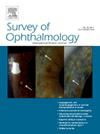Optic disc drusen-associated neovascularization: A systematic review
IF 5.9
2区 医学
Q1 OPHTHALMOLOGY
引用次数: 0
Abstract
We have integrated current evidence of visual outcomes in optic disc drusen-associated choroidal neovascularization (ODD-CNV). We systematically reviewed all published ODD-CNV cases from 1974 to 2024 using three databases (PubMed, EMBASE, and Web of Science). Only studies reporting baseline visual acuity, follow-up visual acuity, and an intervention were included. Methodological quality was assessed using a standardized tool for case reports. Seventy-four eyes (65 patients) were identified from 48 eligible articles. The median age of the subjects was 13 years (range: 3–75), and 63.5 % were females. CNVs were mainly peripapillary, with 45.7 % of them progressing into the macula. On average, the eyes had a follow-up period of 21.5 months. Overall, treatment (of any type) showed better outcomes (0.53 LogMAR improvement, > 3 lines on Snellen chart) compared to observation only (0.09 LogMAR improvement). Anti-vascular endotheial growth factor (VEGF) injections and laser photocoagulation, the most frequently used interventions, showed 0.62 and 0.19 LogMAR improvement, respectively; however, the difference was not statistically significant (p = 0.05398). Among 24 pediatric eyes, anti-VEGF showed 0.71 LogMAR improvement with minimal side effects and recurrence in one eye only. When stratified by age, pediatric patients experienced a greater LogMAR improvement compared to adults, even when adjusting for anti-VEGF treatment (p = 0.0279). Our findings highlight the importance of intervention in ODD-CNV patients, particularly in the younger population, as they are more responsive to treatment. Anti-VEGF demonstrates great efficacy and safety profile in the pediatric population.
视盘毒品相关的新生血管:系统综述。
我们整合了视盘毒品相关脉络膜新生血管(ODD-CNV)的视觉结果的现有证据。我们使用三个数据库(PubMed、EMBASE和Web of Science)系统地回顾了1974年至2024年发表的所有ODD-CNV病例。仅包括报告基线视力、随访视力和干预措施的研究。使用标准化的病例报告工具评估方法学质量。从48篇符合条件的文章中鉴定出74只眼睛(65名患者)。受试者年龄中位数为13岁(范围:3-75岁),63.5%为女性。CNVs主要发生在乳头周围,进展到黄斑的占45.7%。这些眼睛的平均随访时间为21.5个月。总体而言,治疗(任何类型)与仅观察(0.09 LogMAR改善)相比显示出更好的结果(0.53 LogMAR改善,Snellen图上bb0.3线)。抗vegf注射和激光光凝是最常用的干预措施,分别改善0.62和0.19 LogMAR;但差异无统计学意义(p = 0.05398)。在24只儿童眼睛中,抗vegf显示0.71 LogMAR改善,副作用最小,仅在一只眼睛中复发。当按年龄分层时,与成人相比,儿科患者的LogMAR改善更大,即使在调整抗vegf治疗时也是如此(p = 0.0279)。我们的研究结果强调了对ODD-CNV患者进行干预的重要性,特别是在年轻人群中,因为他们对治疗更有反应。抗vegf在儿科人群中显示出良好的疗效和安全性。
本文章由计算机程序翻译,如有差异,请以英文原文为准。
求助全文
约1分钟内获得全文
求助全文
来源期刊

Survey of ophthalmology
医学-眼科学
CiteScore
10.30
自引率
2.00%
发文量
138
审稿时长
14.8 weeks
期刊介绍:
Survey of Ophthalmology is a clinically oriented review journal designed to keep ophthalmologists up to date. Comprehensive major review articles, written by experts and stringently refereed, integrate the literature on subjects selected for their clinical importance. Survey also includes feature articles, section reviews, book reviews, and abstracts.
 求助内容:
求助内容: 应助结果提醒方式:
应助结果提醒方式:


